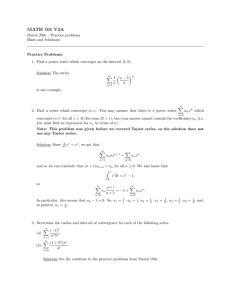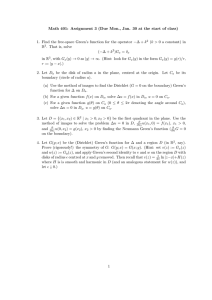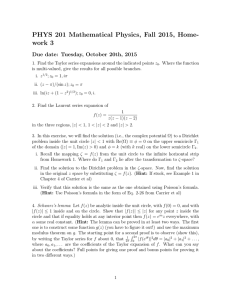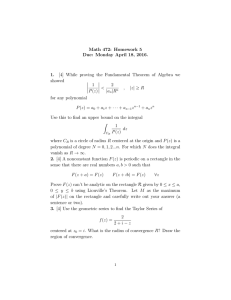Natural Boundary of Random Dirichlet Series
advertisement
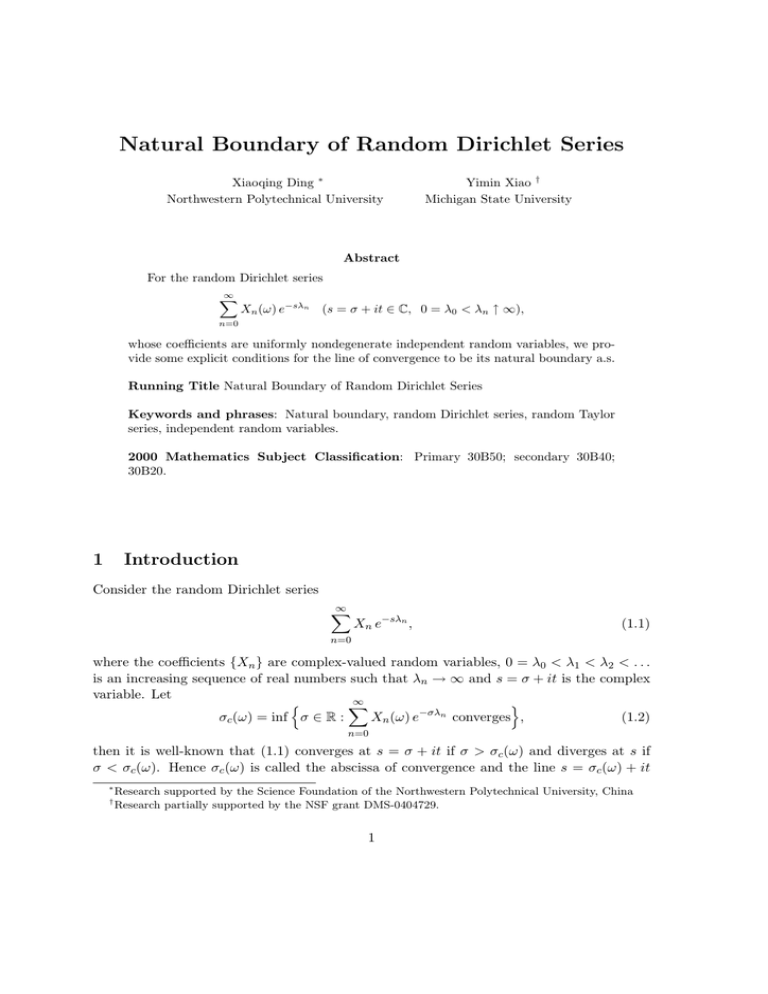
Natural Boundary of Random Dirichlet Series
Xiaoqing Ding ∗
Northwestern Polytechnical University
Yimin Xiao †
Michigan State University
Abstract
For the random Dirichlet series
∞
X
Xn (ω) e−sλn (s = σ + it ∈ C, 0 = λ0 < λn ↑ ∞),
n=0
whose coefficients are uniformly nondegenerate independent random variables, we provide some explicit conditions for the line of convergence to be its natural boundary a.s.
Running Title Natural Boundary of Random Dirichlet Series
Keywords and phrases: Natural boundary, random Dirichlet series, random Taylor
series, independent random variables.
2000 Mathematics Subject Classification: Primary 30B50; secondary 30B40;
30B20.
1
Introduction
Consider the random Dirichlet series
∞
X
Xn e−sλn ,
(1.1)
n=0
where the coefficients {Xn } are complex-valued random variables, 0 = λ0 < λ1 < λ2 < . . .
is an increasing sequence of real numbers such that λn → ∞ and s = σ + it is the complex
variable. Let
∞
o
n
X
Xn (ω) e−σλn converges ,
(1.2)
σc (ω) = inf σ ∈ R :
n=0
then it is well-known that (1.1) converges at s = σ + it if σ > σc (ω) and diverges at s if
σ < σc (ω). Hence σc (ω) is called the abscissa of convergence and the line s = σc (ω) + it
∗
†
Research supported by the Science Foundation of the Northwestern Polytechnical University, China
Research partially supported by the NSF grant DMS-0404729.
1
(t ∈ R) is called the convergence line of the random Dirichlet series (1.1). It is known that
the sum fω (s) of (1.1) is analytic in the half-plane {s = σ + it : σ > σc (ω)}.
When the coefficients {Xn , n ≥ 0} are independent, the Kolmogorov zero-one law implies that σc (ω) = σc a.s. for some constant −∞ ≤ σc ≤ ∞. It has been of importance to
answer the following two natural questions: (a) how do we determine σc ? (b) when is the
line of convergence σ = σc the natural boundary of the series (1.1) itself?
In the special case of λn = n for all n ≥ 0, (1.1) is reduced to a random Taylor series in
∞
P
z = es . The natural boundary problem for random Taylor series F (z) =
Xn z n (z ∈ C)
n=0
has been investigated by several authors. We refer to Kahane (1985) and the references
therein for more information. A fundamental theorem in this area is due to Ryll-Nardzewski
(1953) who proved the following conjecture of Blackwell: If the coefficients {Xn , n ≥ 0} are
∞
P
independent, then there exists a deterministic Taylor series f (z) =
an z n such that
n=0
(i) the circle of convergence of
∞
P
(Xn −an ) z n is a.s. a natural boundary for F (z)−f (z);
n=0
(ii) the radius of convergence r(F − f ) of
choice of deterministic Taylor series.
∞
P
(Xn − an ) z n is maximal with respect to the
n=0
(iii) if g(z) is another deterministic Taylor series such that r(F − g) = r(F − f ) a.s. then
the circle of convergence of F (z) − g(z) is a.s. its natural boundary.
Kahane (1985, pp. 40–41) gives a simplified alternative proof of Ryll-Nardzewski’s result
and, moreover, he proves that if the coefficients {Xn , n ≥ 0} are symmetric, then the
circle of convergence is a natural boundary for F (z). As a related result, we also mention
that Holgate (1983) has proved that Ryll-Nardzewski’s result still holds for certain random
Taylor series with dependent coefficients.
The question (b) for random Dirichlet series (1.1) with independent coefficients has been
addressed by Kahane (1985, Section 6 of Chapter 4). In particular, he has extended the
above result of Ryll-Nardzewski to random Dirichlet series and has shown that the line
of convergence is the natural boundary for (1.1) provided the coefficients {Xn , n ≥ 0} are
independent and symmetric random variables.
However, if the coefficients {Xn , n ≥ 0} are not assumed to be symmetric, Kahane’s
result does not give any information about the location of the natural boundary of random
Dirichlet series (1.1). Even in the special case of random Taylor series, very little has been
known. Sun (1991) has considered the natural boundary problem for random Taylor series
with non-symmetric independent coefficients, but his condition is rather restrictive; see
Remark 3.6.
The objective of this paper is to investigate the questions (a) and (b) above for random
Dirichlet series (1.1) with independent and uniformly nondegenerate coefficients {Xn , n ≥ 0}
[see Section 2 for definition]. We will provide some explicit conditions for (1.1) to have
a.s. the convergence line as its natural boundary. When applied to random Taylor series,
our result gives a more convenient condition for the convergence circle to be the natural
boundary a.s.
2
We remark that the existence of singular points on the convergence line for random
Dirichlet series (1.1) whose coefficients {Xn , n ≥ 0} form a martingale difference sequence
has been considered by Ding (1998). However, as far as we know, no results on the natural
boundary of such series have been established. Similarly, the problem of finding the location
of natural boundaries for the random Taylor series considered by Holgate (1983) is also open.
For general references on other aspects of deterministic and random Dirichlet series such as
convergence, growth and value distributions, we refer to Mandelbrojt (1972) and Yu (1997).
2
Main result and its proof
Consider the random Dirichlet series
∞
X
Xn (ω) e−sλn
(s = σ + it, 0 = λ0 < λn ↑ ∞),
(2.1)
n=0
where {Xn , n ≥ 0} is a sequence of independent, complex-valued random variables defined
on a complete probability space (Ω, F, P) such that
sup sup P{Xn = a} < 1.
(2.2)
n≥0 a∈C
Any sequence {Xn , n ≥ 0} of random variables satisfying (2.2) is said to be uniformly
nondegenerate. Clearly, the Rademacher sequence, Steinhaus sequence and, more generally,
any sequence of continuous random variables are uniformly nondegenerate in the above
sense. It is verified in Lemma 2.2 that the condition (2.2) holds if and only if there is a
sequence {Rn } of positive numbers such that
ª
©
(2.3)
sup sup P |Xn − a| ≤ Rn < 1.
n≥0 a∈C
This property is connected with the Stein property of {Xn }; see Burkholder (1968).
(1)
Let σc be the abscissa of convergence of the series (2.1), which is a constant or infinity
(2)
a.s. by Kolmogorov’s zero-one law. Denote by σc the abscissa of convergence of the
Dirichlet series
∞
X
Rn2 e−2sλn .
(2.4)
n=0
The main result of the paper is as follows.
Theorem 2.1 Let {Xn , n ≥ 0} be a sequence of independent complex-valued random variables satisfying the condition (2.2). Then
(1)
(i) σc
(2)
≥ σc
(1)
(ii) If σc
a.s.
< ∞, then with probability one for every rational number t the disc
¯
¯
n
o
¯
¯
s ∈ C : ¯s − (σc(1) + 1 + it)¯ ≤ σc(1) + 1 − σc(2)
contains at least one singularity of the series (2.1).
3
(1)
(2)
(1)
(iii) If σc = σc < ∞, then with probability one the line Re s = σc
boundary of the series (2.1).
is the natural
In §3, we will give some sufficient conditions on the sequences {Xn n ≥ 0} and {λn , n ≥
(1)
(2)
0} so that σc = σc a.s.
For the proof of Theorem 2.1, we need the following two lemmas.
Lemma 2.2 The condition (2.2) holds if and only if there is a sequence {Rn } of positive
numbers such that (2.3) holds.
Proof The condition (2.3) implies clearly the condition (2.2). The reverse follows immediately from the following proposition1 : If a random variable X has the property that for
some constant ε ∈ (0, 1),
©
ª
sup P X = a ≤ 1 − ε,
(2.5)
a∈C
then there exists a constant R > 0 such that
©
ª
ε
sup P |X − a| ≤ R ≤ 1 − .
2
a∈C
(2.6)
Assume the above proposition does not hold. Then for every integer n ≥ 1, there exists
an ∈ C such that
n
ε
1o
(2.7)
>1− .
P |X − an | ≤
n
2
We may choose {an , n ≥ 1} such that either lim |an | = ∞ or lim an = a∞ ∈ C. In the
n→∞
© n→∞ ª
first case, (2.7) implies that for every positive number C, P |X| ≥ C ≥ 1 − 2ε , which is
impossible. In the second case, we note that for an arbitrary δ > 0, we can choose n > 2δ
such that |a∞ − an | < 2δ . Hence by (2.7) we derive
n
©
ª
1o
ε
P |X − a∞ | ≤ δ ≥ P |X − an | ≤
>1− .
n
2
ª
©
ε
Letting δ → 0+, we obtain that P X = a∞ ≥ 1 − 2 , which contradicts (2.5). The proof
of Lemma 2.2 is completed.
¤
Lemma 2.3 below is a consequence of Lemma 2.2 and Corollary 2 of Burkholder (1968).
It extends Theorem 1 in Chapter 2 of Kahane (1985).
Lemma 2.3 Let {Xn , n ≥ 0} be a sequence of independent complex-valued random variables satisfying the condition (2.2). Suppose {b
Pmn , m, n ≥ 0} is a double sequence of complex
numbers such that for each m ≥ 0 the series ∞
n=0 bmn Xn converges a.s. to a random variable Ym . If the sequence {Ym , m ≥ 0} is convergent a.s., then there is a sequence {bn , n ≥ 0}
of complex numbers such that
lim
m→∞
1
∞
X
|bmn − bn |2 Rn2 = 0,
n=0
and
∞
X
|bn |2 Rn2 < ∞.
n=0
The proof of (2.6) is suggested by the referee. It is simpler than our original proof.
4
(2.8)
Proof
Put Zn = Xn /Rn . Then Lemma 2.2 implies that
sup sup P {|Zn − a| < 1} < 1.
n≥0 a∈C
Now by applying Corollary 2 of Burkholder (1968) to the series
plete the proof.
P∞
n=0 (bmn Rn )Zn
we com¤
(1)
Proof of Theorem 2.1
In order to prove (i), we assume σc < ∞; otherwise there
(1)
is nothing to prove. For any σ > σc the random Dirichlet series (2.1) converges a.s. for
s = σ. By applying Lemma 2.3 to bmn = e−σλn , we see that the series (2.4) converges at
(2)
s = σ. Hence σc ≤ σ so that (i) holds.
Next we prove (ii). Let fω (s) be the sum function of the random Dirichlet series (2.1)
(1)
for Re s > σc . For t ∈ R, put
"
¯ f (n) (σ (1) + 1 + it) ¯ 1
¯ ω
¯n
c
R(t, ω) = lim sup ¯
¯
n!
n→∞
#−1
,
(2.9)
where f (n) denotes the n-th derivative of f . Then R(t, ω) is the radius of convergence of
(1)
the Taylor expansion of fω (s) around s0 = σc + 1 + it. Suppose (ii) is not true, then there
is a rational number t0 such that, with positive probability, the disc
n
o
¯
¯
s ∈ C : ¯s − (σc(1) + 1 + it0 )¯ ≤ σc(1) + 1 − σc(2)
does not contain any singularities of the series (2.1). This implies that
n
o
P R(t0 , ω) > σc(1) + 1 − σc(2) > 0.
(2.10)
,
However, by Kolmogorov s zero-one law and (2.10), R(t0 , ω) is a.s. a constant R(t0 ) so that
R(t0 , ω) = R(t0 ) > σc(1) + 1 − σc(2) a.s.
(2)
Now we choose σ0 < σc
(2.11)
(1)
such that R(t0 ) > σc + 1 − σ0 and let
n
o
Ω0 = ω : R(t0 , ω) > σc(1) + 1 − σ0 .
Then (2.11) implies P {Ω0 } = 1.
(1)
(2)
Put ζ0 = σc + 1 + it0 . Since σ0 < σc we can choose s1 (e.g. s1 =
that
|s1 − ζ0 | < σc(1) + 1 − σ0 , σ0 < Re s1 = σ1 < σc(2) .
(2)
σ0 +σc
2
+ it0 ) such
(2.12)
For each ω ∈ Ω0 , we consider the Taylor series
Y (ω) =
∞
(n)
X
fω (ζ0 )
n=0
n!
5
(s1 − ζ0 )n .
(2.13)
(1)
It follows from (2.11) and R(t0 , ω) > σc + 1 − σ0 > |s1 − ζ0 | that (2.13) is convergent for
every ω ∈ Ω0 . Now put
m
(k)
X
φn (ζ0 )
bmn =
(s1 − ζ0 )k ,
k!
k=0
P
−sλ
n
where φn (s) = e
. Then for every m ≥ 0, the series ∞
n=0 bmn Xn converges a.s. to the
series
m
∞
m
X
X
(s1 − ζ0 )k X (k)
(s1 − ζ0 )k (k)
φn (ζ0 )Xn (ω) =
fω (ζ0 ) =
ˆ Ym (ω).
k!
k!
n=0
k=0
k=0
Moreover, (2.13) implies that the sequence {Ym (ω), m ≥ 0} converges a.s. to the random
variable Y (ω). Therefore it follows from Lemma 2.3 and lim bmn = φn (s1 ) = e−s1 λn that
m→∞
∞
X
Rn2 e−2λn Re s1 < ∞
n=0
(2)
so that the series (2.4) converges for Re s1 < σc [see (2.12)]. This is a contradiction, which
proves (ii).
(1)
Finally we prove (iii). Since the series (2.1) converges a.s. in the half plane: Re s > σc ,
we have inf R(t, ω) ≥ 1 a.s., where Q is the set of rational numbers. On the other hand, by
t∈Q
(1)
(ii) and the hypothesis that σc
(2)
= σc , we have sup R(t, ω) ≤ 1 a.s. Therefore R(t, ω) = 1
t∈Q
(1)
σc
a.s. for all t ∈ Q, that is,
+ it is a singularity of the function fω (s) with probability
one. Therefore, (iii) follows readily from the facts that Q is dense in R and the set of the
singularities of an analytic function is closed. This finishes the proof of Theorem 2.1.
¤
3
Three corollaries
In this section, we apply Theorem 2.1 to random Dirichlet series and random Taylor series
with different conditions on their coefficients and to derive more explicit results on the line
of convergence and natural boundary.
3.1 First we consider the random Dirichlet series (2.1) with coefficients {Xn } which are
identically distributed, independent and uniformly nondegenerate random variables. We
assume further that either
E{|X0 |β } < ∞
or
for some β ∈ (0, 1)
E(X0 ) = 0 and E{|X0 |β } < ∞ for some β ∈ [1, 2].
Theorem 3.1 Under the above assumptions, the following statements hold:
(i)
D
2
(1)
≤ σc
≤
D
β,
where D = lim supn→∞
log n
λn .
(ii) If D = 0, the line Re s=0 is a.s. the natural boundary of the series (2.1).
6
(3.1)
(3.2)
Remark 3.2 Theorem 3.1 applies directly to random Dirichlet series (2.1) whose coefficients are i.i.d. stable random variables.
Proof (i) Since the random variables {Xn , n ≥ 0} are identically distributed and uniformly nondegenerate, it follows from Lemma 2.2 that (2.3) is valid for P
Rn = R, where
2 −2sλn .
R > 0 is some positive constant. Hence the series (2.4) reduces to the series ∞
n=0 R e
(2)
Clearly, its abscissa σc of convergence is at least 0. When D > 0, then it is known [see,
(2)
e.g., Yu (1997) or Mandelbrojt (1972)] that σc = D/2. Hence by (i) of Theorem 2.1 we
(1)
always have D/2 ≤ σc .
(1)
To prove σc ≤ D/β we assume without loss of generality that D < ∞. Note that for
any ε > 0, the series
∞
∞
¯
n¯
X
X
(D+ε)λn β o
©
ª
¯
¯
−
β
=
E ¯Xn e
E |Xn |β e−(D+²)λn ,
¯
n=0
n=0
is obviously convergent. It follows from (3.1), (3.2) and Corollary 3 in Chow and Teicher
(1978, p.114) that the series (2.1) converges a.s. for s = (D + ²)/β. Since ε > 0 is arbitrary,
(1)
this implies σc ≤ D
β , as desired.
(1)
When D = 0, from the above we have σc
directly from (i) and Theorem 2.1 (iii).
(2)
= σc
= 0. Hence the statement (ii) follows
¤
3.2 Now we consider the random Dirichlet series (2.1) where {Xn } is a sequence of
independent random variables satisfying the following condition: there exists a constant
α > 0 such that
©
ª
E {Xn } = 0 and 0 < α E1/2 |Xn |2 ≤ E {|Xn |} ,
(∀n ≥ 0).
(3.3)
This condition was introduced by Marcinkiewicz and Zygmund (1937) to establish maximal
inequalities for the weighted partial sums of independent random variables {Xn , n ≥ 0}
∞
P
with mean 0 and variance 1 and to study the convergence of the random series
a n Xn .
n=0
A conditional version of (3.3) was formulated by Gundy (1967) [who called it Condition
(MZ)∗ ] for extending the results of Marcinkiewicz and Zygmund (1937) to sequences of
martingale differences. See Stout (1974) and the references therein for further information.
The following lemma gives a sufficient condition for (3.3) to hold and it follows from a
remark of Marcinkiewicz and Zygmund (1937, p.70).
Lemma 3.3 Let {Xn , n ≥ 0} be a sequence of independent random variables with mean 0.
If there exist constants 0 < η < 1 and K > 0 such that
£
¤
E |Xn |2 1lAn ≤ η, ∀n ≥ 0,
(3.4)
where An = {|Xn | ≥ K E1/2 (|Xn |2 )}. Then (3.3) holds with α = (1 − η)/K.
(3)
Let σc
be the abscissa of convergence of the Dirichlet series
∞
X
E2 {|Xn |} e−2sλn .
n=0
7
(3.5)
Theorem 3.4 Let {Xn , n ≥ 0} be a sequence of independent random variables satisfying
the condition (3.3). Then the following statements hold:
(1)
(i) σc
(3)
= σc
(3)
(ii) If σc
(2.1).
Proof
a.s.
(3)
is finite, then the line Re s = σc
(3)
For any σ > σc , the series
(3.3) that the series
∞
P
n=0
is a.s. the natural boundary of the series
E2 {|Xn |} e−2σ λn is convergent. It follows from
∞
X
©
ª
E |Xn |2 e−2σ λn
n=0
also converges. Hence the random Dirichlet series (2.1) converges a.s. at s = σ. Conse(1)
(3)
quently, we have σc ≤ σc .
To prove the reverse inequality, by (i) and (iii) of Theorem 2.1 it is sufficient to prove
n
©
ªo
α
< 1.
(3.6)
sup sup P |Xn − a| ≤ E1/2 |Xn |2
4
n≥0 a∈C
©
ª
That is, {Xn , n ≥ 0} satisfies (2.3) with Rn = α4 E1/2 |Xn |2 . In fact, the inequality (3.6)
is a consequence of the following claim: If X is a random variable such that
E {X} = 0
then
and 0 < α E1/2 {|X|2 } ≤ E {|X|} ,
n
©
ªo
α
1 ³ α ´2
sup P |X − a| ≤ E1/2 |X|2
.
≤1−
4
8 2+α
a∈C
(3.7)
(3.8)
Now let us prove the above claim. Since E{X} = 0, Jensen’s inequality and the triangle
inequality imply that for all a ∈ C,
E {|X − a|} ≥ |a|
and E {|X − a|} ≥ E {|X|} − |a| .
Hence by (3.9) and the easily verifiable inequality
x
inf max {y, x − y} ≥
y≥0
2
we have
(3.9)
(∀ x > 0),
©
ª 1
E {|X − a|} ≥ max |a| , E{|X|} − |a| ≥ E {|X|} .
(3.10)
2
It follows from (3.10) and the Paley-Zygmund inequality [cf. Kahane (1985, p. 8)] that for
any λ ∈ (0, 1),
¾
½
©
ª
λ
≥ P1/2 |X − a| > λ E {|X − a|}
P1/2 |X − a| > E {|X|}
2
E {|X − a|}
≥ (1 − λ)
©
ª
1/2
E
|X − a|2
1 − λ max {|a| , E {|X|} − |a|}
√
.
≥
©
ª
2
E1/2 |X|2 + |a|
8
By taking λ = 1/2 and then using the equality
¯
½
¾
y
x1 − y
max {y, x1 − y}
y ¯¯
inf
≥ inf max
,
=
y≥0
y≥0
x2 + y
x2 + y x2 + y
x2 + y ¯y= x1
2
x1
(∀x1 > 0, x2 > 0),
=
2x2 + x1
we have that for all a ∈ C,
n
o
1
1
E {|X|}
P1/2 |X − a| > E {|X|} ≥ √
.
©
ª
4
2 2 2E1/2 |X|2 + E {|X|}
(3.11)
It is easy to see that (3.8) follows from (3.7) and (3.11). Therefore the proof of Theorem
3.4 is finished.
¤
3.3 Finally, we apply Theorem 3.4 to the random Taylor series
∞
X
Xn (ω) z n ,
(3.12)
n=0
where the sequence {Xn } satisfies the conditions imposed in Theorem 3.4. Consider the
auxiliary series
∞
X
E2 {|Xn |} z 2n .
(3.13)
n=0
Since the series (3.12) and (3.13) can be regarded as special cases of the series (2.1) and
(3.5), respectively, we have the following corollary of Theorem 3.4.
Theorem 3.5 Under the conditions of Theorem 3.4,
(i) The radius of convergence of the series (3.12) is a.s.
r=
1
lim sup (E{|Xn |})1/n
.
n→∞
(ii) If the radius r is finite and positive, then the circle |z| = r is a.s. the natural boundary
of the random Taylor series (3.12).
Remark 3.6 Theorem 3.5 gives more concise information about the natural boundary of
random Taylor series than that of Sun (1991), who has proved that the natural boundary
∞
P
of the random Taylor series
Yn (ω) z n is the circle
n=0
|z| =
1
³p
´ 1/n ,
lim sup
E{|Yn |2 }
n→∞
9
provided {Yn } is a sequence of independent random variables with mean 0 and finite second
moments satisfying the following condition: there exists a constant δ > 0 such that for
every event A with P{A} < δ,
Z
|Yn |2
1
inf
dP > ,
(3.14)
n≥0 Ac E{|Yn |2 }
2
¡
where
Ac is the complement of A. Condition (3.14) is equivalent to assuming E |Yn |2 1lA ) <
¡
E |Yn |2 1lAc ) holds uniformly for all events A with P{A} < δ and all integers n ≥ 0.
We now show that the condition (3.14) implies (3.3). Without loss of generality, we
will assume E(|Yn |2 ) = 1 for all n ≥ 0. Then Chebyshev’s inequality implies that for any
δ ∈ (0, 1), there exists a constant K > 0 such that
©
ª
sup P |Yn | ≥ K < δ.
(3.15)
n≥0
Let An = {|Yn | ≥ K}. It follows from (3.14) and (3.15) that E(|Yn |2 1lAn ) ≤ 1/2 for all
integers n ≥ 0. Hence by Lemma 3.3 we see that (3.3) holds.
The following is an example of independent random variables {Yn , n ≥ 0} that verifies
the condition (3.3), but not the condition (3.14).
Example 3.7 Let {An , n ≥ 0} be a sequence of events with P(An ) = (1 + n)−2 . We define
a sequence of independent real-valued random variables {Yn , n ≥¡0} with mean 0 such that
|Y¡n | = 1 + n on Acn and |Yn | = (1 + n)2 on An . Then we have E |Yn |2 1lAn ) = (1 + n)2 and
E |Yn |2 1lAcn ) = (1 + n)2 (1 − (1 + n)−2 ), so (3.14) does not hold. On the other hand, it is
√
easy to see that the condition (3.3) is verified with α = ( 2)−1 .
Acknowledgements. The work of this paper was done during the first author’s visit
to the Department of Statistics and Probability at Michigan State University. He thanks
the hospitality of the department.
The authors thank the referee for his/her comments that have led to several improvements of this paper.
References
[1] Burkholder, D. L. (1968), Independent sequence with the Stein property. Ann. Math.
Statist., 39, 1282–1288.
[2] Chow, Y. S. and Teicher, H. (1978), Probability Theory: Independence, Interchangeability, Martingales. Springer-Verlag, Berlin and New York.
[3] Ding, X. Q. (1998), The singular points and Picard points of random Dirichlet series.
J. of Math. (PRC), 18, 455–460.
[4] Gundy, R. F. (1967), The martingale version of a theorem of Marcinkiewicz and
Zygmund. Ann. Math. Statist., 38, 725–734.
[5] Holgate, P. (1983), The natural boundary problem for random power series with
degenerate tail fields. Ann. Proab., 11, 814–816.
10
[6] Kahane, J.-P. (1985), Some Random Series of Functions. 2nd ed., Cambridge University Press, Cambridge.
[7] Mandelbrojt, S. (1972), Dirichlet Series. Principles and Methods. D. Reidel Publishing
Co., Dordrecht.
[8] Marcinkiewicz, J. and Zygmund, A. (1937), Sue les fonctions indépendantes. Fund.
Math., 29, 60–90.
[9] Paley, R. E. A. C. and Zygmund, A. (1932), On some series of functions (3). Proc.
Camb. Phil. Soc., 28, 190–205.
[10] Ryll-Nardzewski, C. D. (1953), Blackwell’s conjecture on power series with random
coefficients. Studia Math., 13, 30–36.
[11] Stout, W. F. (1974), Almost Sure Convergence. Academic Press, New York.
[12] Sun, D. C. (1991), The natural boundary of some random power series. Acta Mathematica Scientia, 11, 463–470.
[13] Yu, J. R. (1997), Dirichlet Series and Random Dirichlet Series. Scientific Press, Beijing.
Xiaoqing Ding. Department of Applied Mathematics, Northwestern Polytechnical
University, Xi, an 710072, China
Email: dingxq@nwpu.edu.cn
Yimin Xiao. Department of Statistics and Probability, A-413 Wells Hall, Michigan
State University, East Lansing, MI 48824, U.S.A.
E-mail: xiao@stt.msu.edu
URL: http://www.stt.msu.edu/~xiaoyimi
11




